#based on ring tail and sifaka lemurs!!!!
Text
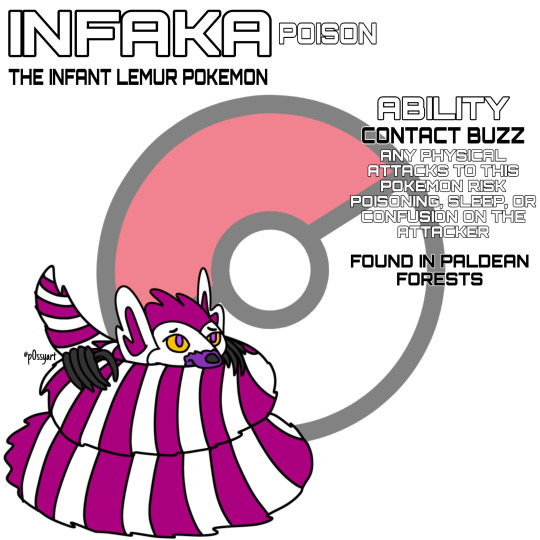

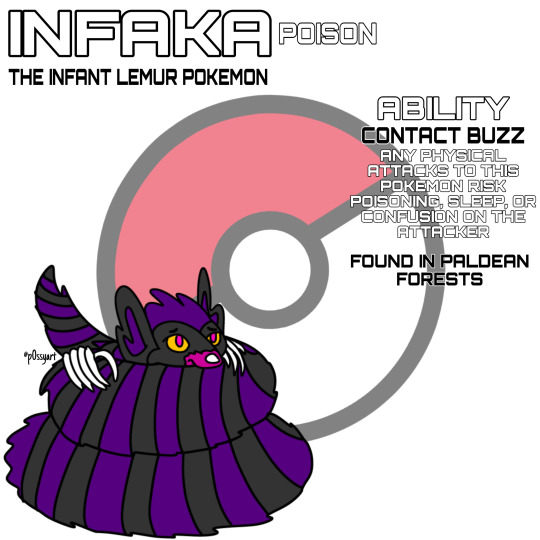

lemur fakemon based on how lemurs will use millipedes for recretional purposes, dex entries and transparents below!


INFAKA - THE INFANT LEMUR POKEMON
"infaka keep themselves wrapped in their oversized tails, only a loving parent or a loving trainer can help it gain the confidence to reveal itself"
"infaka adore music, they will excitedly watch a musical street performance and some performers have even gotten them to start dancing from joy"

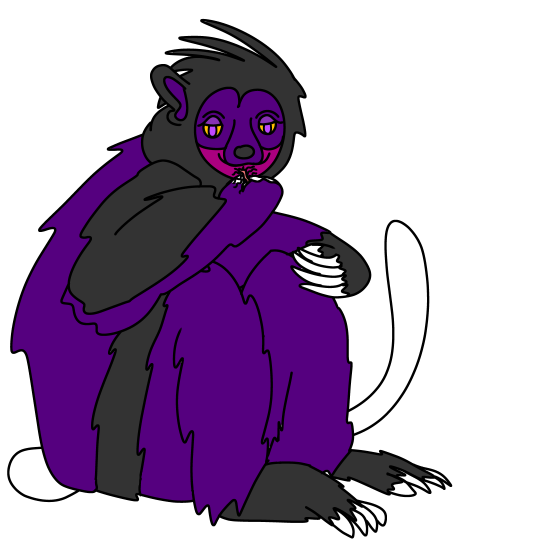
ZAHBOO - THE MEDICINE MAN POKEMON
"zahboo are natural enemies of grafaiai, they can be found fighting over territories, meals, sometimes even nothing at all"
"zahboo are constantly seen eating highly poisonous insects and plants, researchers discovered that this is because their body processes the toxins very well, thus its used for medicinal and recreational purposes by the pokemon"
#i love making fakemon omg theyre so fun#digital art#pokemon#fakemon#paldean fakemon#lemur fakemon#poison fakemon#based on ring tail and sifaka lemurs!!!!
5 notes
·
View notes
Text
I'm gonna say something maybe controversial but Momo looked better in the 2010 film than the new live action show.

like not by a lot, but basing him around real coquerel's sifakas and ring-tailed lemurs made him feel way more grounded. 2024 Momo is inching a little too close to uncanny valley/obviously CGI territory. I think they tried too hard to keep him cartoon accurate and it kinda backfired.
#they could have just used a real juvenile sifaka and cg'd the wings and ears on later tbh#jovian (you know him as zoboomafoo) has grandkids that might have been options#would have worked#natla
3 notes
·
View notes
Text
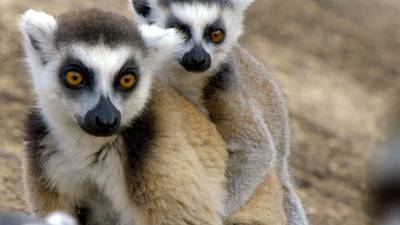
Land of Primates - Smithsonian Channel
Nature Film Review
The Smithsonian Channel is an inexplicably underrated source of nature documentaries, brilliantly balancing the educational with the cinematic. The BBC will always be the final word, but Smithsonian is a fantastic place to stream films to fulfill your need for nature.
The series on African primates is particularly fascinating, focusing on relatively unsung species. Found across the continent in nearly every habitat save the most extreme desert, primates exhibit a winning design. The Geladas of the Ethiopian highlands grazing on high altitude grasses to the Poison monkeys of Zanzibar show off the ability of primates to succeed in virtually any habitat. The series spends an episode on the Ring tailed lemurs of Anja mountain in Madagascar, befitting a charismatic species that shows a talent for adaptation.
‘Lemurs of Madagascar’ covers the various other lemur and primate species, as the isolation of that great island has allowed a truly remarkable evolutionary branch to flourish. Of its species, 80% are endemic, found nowhere else on Earth. The massive island is bisected by a spine of mountains that run vertically down the island, acting as a rain shield holding wet weather in the east with forest conditions. The mountain itself is a haven for ring tailed lemurs, as seen in the first episode. The west of the island holds some of the most hostile arid conditions on the planet. Life has taken up this challenge, with even the impossibly dry ‘spiny forest’ still frequented by Verreau’s Sifaka. Leaping from one Alluaudia tree to another, biologists still cannot explain how they avoid impaling themselves on the lethal thorns that cover the trees.
Even Ring-tailed Lemurs find resources to exploit in an otherworldly habitat of titanic grey edifices resembling alien skyscrapers, the only remains of an ancient ocean reef. The razor sharp stone is negotiated by the lemur troops, navigated by experienced scouts down to the base where sheltered groves collect water from the rocks above, rare places to hunt for food. The aye-aye is examined, with its bizarre adaptations bringing it success in hunting the wood for insects. Its strange appearance has been a curse, as humans mistake it for a demon, and kill it on sight. Fat-tailed lemurs occupying the rain forests of the east are the only primate and tropical mammal that hibernates; a process called aestivation, sleeping for seven months to conserve resources during lean times. Lastly, the episode looks in on the Indri of the forest, haunting the trees with its plaintive call. The endless wonder of Madagascar is captured with incredible images that easily achieve a visual poetry while the narrator covers the fun facts.
‘Wanderers of the Forest’ focuses on the Amathole mountains of south eastern South Africa, an Afromontane habitat that has been nearly destroyed by timber and farming interests. Covering less than 0.5% of South Africa’s surface area, it is the last bastion of the towering 200 foot high Yellowwood trees. This is the ‘national tree’, which is still cut down regularly despite its protected status and very slow reproduction.
These forests are the home and prison of Samango monkeys and South Africa’s only parrot species, the Cape Parrot. Though there are small pockets of the forest left, the devastation requires each species to forage in urban areas for food. Samango monkeys, adorned with greyed fur that makes them resemble old men, cross telephone wires into town to raid gardens and ruin their teeth on acorns for protein. The residents shoot them on sight in the town of Hogsback, an unfortunate reminder of humans’ refusal to understand their place in the natural world. The parrots raid the pecan fields, relishing the fatty pecans which provide nourishment, but cause high fat levels in the liver. Farmers have set aside a field just for the parrots while shooting them in their own fields. Both species would live far better on a diet of yellowwood fruit, filled with antioxidants and vitamins. ‘Wanderers of the Forest’ makes a strong case for conservation of species by conserving the habitat, while highlighting the bizarre behaviors of our own species.
‘Baboons of Bambelela’ is an engaging chapter focusing on the Chacma baboons of the Waterberg, making their living amid the granite inselbergs of this paradise. Baboons tend to have complex troop structures, led by a strong alpha male (for Chacmas), allied adult males, and the various females and offspring, living in 2-3 dozen large groups for predation defense. The higher the risk of predation, as in the Okavango, the larger the troop. This chapter examines a troop created by a rogue male who enticed low ranking females away from their troop where reproductive prospects were poor. The recruitment can consist of not just being an available alpha male, but also grooming, which plays an outsized role in bonding, forming alliances, and political intrigue. The alpha then takes and holds prime feeding territory and maintains tight discipline to keep the troop intact. Males hold rank with muscle, fighting off rivals, protecting family members, and keeping everyone well fed - when he fails in this, he is deposed and forgotten. Females hold rank by bloodline, and keep that rank even if their mate is lost. Their offspring holds rank in a similar fashion, this is carried over as they age, and is reflected in being groomed by subordinates. The grooming is crucial for currying favor, enabling individuals to rise in estimation and importance. It even allows interlopers to join a troop. The notion of animals conducting politics by various means has always been fascinating to me, a literal ‘scratch your back’ quid pro quo that could yield a dividend.
‘Baboon Lagoon’ follows a single Chacma baboon troop living in the reserve of De Hoop. As a misty morning breaks, we see the hulking alpha male lead his troop from their rock haven to the feeding grounds where they pick berries from a Dune Myrtle tree, stuffing their cheek pouches with the bounty. There is little new material in this one, but it is a favorite for showcasing the natural beauty of De Hoop, a small but crucial nature reserve along the South African Garden Route. Home to some of the world’s rarest mammals, De Hoop was created in 1957 south of the Overberg mountains specifically to protect Bontebok antelope. These beautiful creatures with striking white facial coloration were nearly exterminated, down to just seventeen individuals by farmers who shot them as pests. They were joined by Cape Mountain Zebra, also critically endangered, to breed freely and eventually restock reserves. Above all what is conserved here is the Cape Floral Kingdom, home to the Fynbos biome. Forming a packed heath, proteas, ericas, restios and geophytes are packed into a relatively tiny area that has biological diversity greater than any rainforest. Baboons are able to graze here due to their dietary flexibility, adapting to any food source. Fynbos manage to grow on very poor soils, and are thus low in nutrients. The baboons must work harder to make a living than those in more productive areas, but are successful nonetheless.
'Africa’s baboons' is a larger scope review of the five species of baboons found across that massive continent, including the Chacmas, the Olive baboons of western and central Africa, the Geladas, Hamadryas, and Yellow baboons of eastern Africa. Baboons are well built to exploit the remarkable diversity of ecosystems, and unsurprisingly are found nearly everywhere. Chacmas are able to live off the sparse nutrients of the Fynbos kingdom, though will raid human habitation when necessary to survive. Olive baboons are widespread across west-central Africa, capable of eating nearly anything, and are led by an alpha female in large troops. This female carries knowledge of water and food sources that leads back many generations, passed on to offspring to carry on the traditions.
Emotions run deep in these societies, and higher ranking members hold the discipline. In one scene, an alpha attacks a mother who turns her back on a helpless newborn, a valuable lesson in a dangerous world. This unrest causes cortisol levels to surge in the bloodstream, which can disrupt reproductive hormones - and these subside quickly in the calm of grooming sessions, restoring the balance, reinforcing emotional bonds, and aiding troop cohesion. Baboons have been noted by researchers to recognize relationships of dominance within the troop independent of their own position - capable of exercising politics and abstract thought.
The camera follows one rogue male who drifts into the territory of a baboon troop - he is alone, cast out of his old troop once sexually mature. Ever seeking a way into an existing troop, or coaxing away females, he is constantly on the lookout for an opportunity. Social animals face a bleak existence in solitude. One does not need to anthropomorphize to see loneliness in his eyes, unable to bond with others. Ticks build up on his face and back, he feeds fretfully as there is no one to look out for predators, sleep is rare, and stress wears on him without the close interactions baboons desire. Hope appears with another rogue male who carefully approaches, and through body language an alliance is made. Troops are formed this way in the natural world, and the social animal is given another chance.
World of Primates is a stellar series that stands with the best, both as entertainment and education. I find this invigorating as a way of understanding how so many disparate pieces of our planet fit together into a loose whole. Learning how these systems work is the same as learning why they matter - and in a world on the verge of large scale collapse, they all matter.
1 note
·
View note
Text

✨ Lemur Adopts ✨
Just posted these guys on Toyhouse!
Based on a silky sifaka, ring-tailed lemur, crowned sifaka and an indri lemur!
Terms of Service
Paypal/USD only
Art sent after payment
DM or email me to claim!
Boosts appreciated!! 💙
Click to view on Toyhouse!
#adopt#adoptable#adoptables#character design#open adopts#lemur#anthro#furry#silky sifaka#ring tailed lemur#crowned sifaka#indri#indri lemur
26 notes
·
View notes
Text
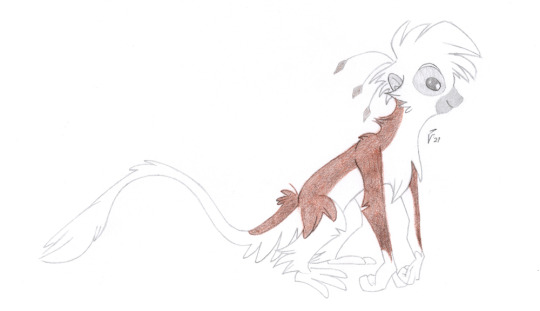
Trying to make an old OC look less like an OC. It's not working.
I'm still debating on whether or not to dock the whole wing thing. She is based on the black and white colobus monkey, which is why she had them in the first place. I still like the idea of a feathery monkey, so I drew influence from the archaeopteryx for her shape. I was inspired by ring-tailed lemurs and sifakas for her colouring. It's not a finalised design, but she’ll get there eventually.
1 note
·
View note